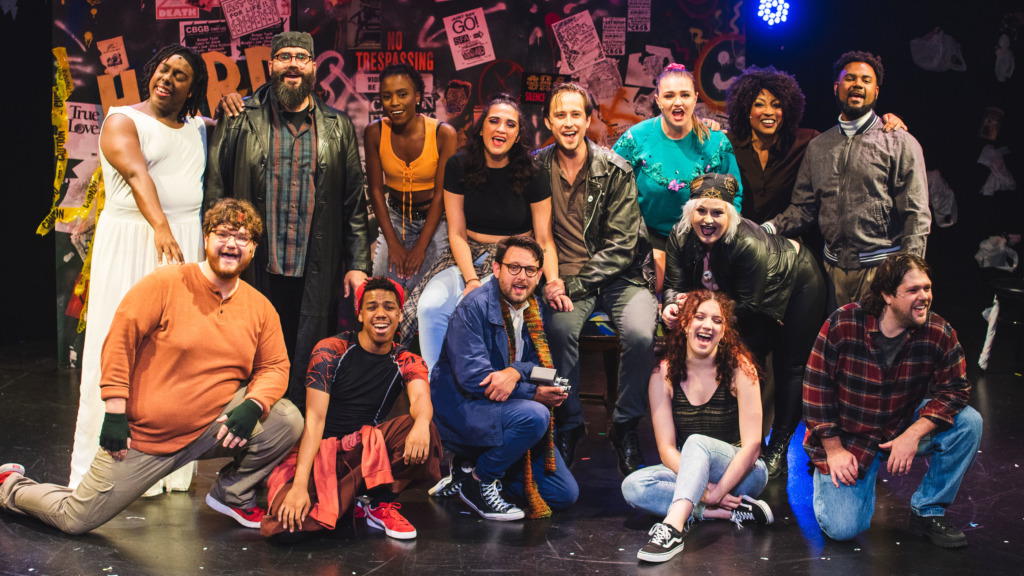Christmas bells are ringing! Christmas bells are singing! Somewhere else— Bal-ti-more! That’s right, the Christmas bells— from Jonathan Larson’s Rent are ringing (in July, no less!) at The Heritage Players, set currently in The Chesapeake Arts Center’s black box theatre. Directed and Choreographed by Tommy Malek with Musical Direction by Rachel Sandler, Rent is an iconic tale from the musical theatre canon which reminds us all of how precious life truly is, living in the moment is particularly important, as none of us are promised tomorrow.
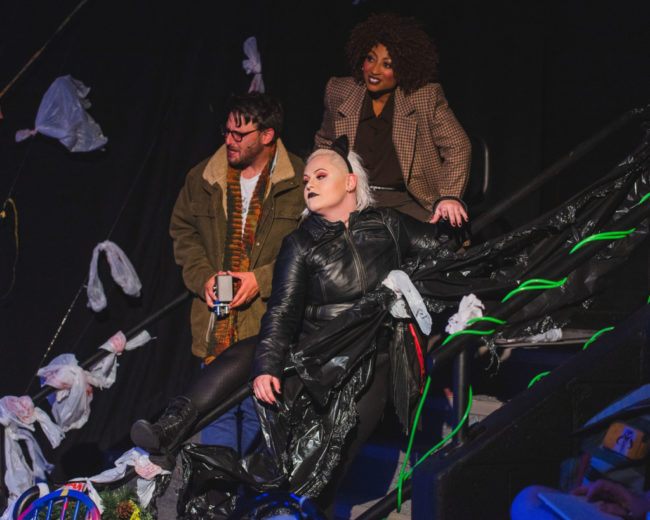
The musical itself is set in the early 1990’s. Director Tommy Malek sets the framework for this era before the show even gets underway with television clips projected onto a white scrim hanging above the set. The extremely evocative ‘pre-start’ to the show features live footage of President Regan (circa 1989) declaring that those attempting to enter the country, currently infected with AIDS are to be barred admission in an attempt to quash the pandemic. There’s also a clip of (an extremely young) Dr. Anthony Fauci discussing the AIDS pandemic and current infection rate before a profound quote from Jonathan Larson is projected. Malek’s groundwork for priming the audience of the show’s timeframe is impressive.
The set design, a combined effort of Malek and Stage Manager Atticus Cooper Boidy, (with construction by Al Gillis) is more abstract. While there is a concrete wall that serves the multipurpose function of all the varying settings, plastered with posters and graffiti tags relevant to the era (and a very cool modpodged table which doubles up as the door busted down in the second act) there’s also a string of white plastic bags looped and laced in an obscurely artistic fashion across the wall and the set itself is roped off from the audience with mangled up, chewed-on yellow crime scene tape. (There are some artistic inferences here that drive the point home a little too intensely, though it doesn’t detract from the insane talent that the company of 14 are pouring out all throughout the performance. And a shout-out to Thomas P. Gardner for lighting design; it matches the overall mood of the show and tone of the various musical numbers in an impressive but subtle and unobtrusive way.)

Here’s where Malek’s artistic vision has a conflict with itself and splits in two opposing directions, which creates some visual dissonance throughout the performance. Malek chooses to keep the entire company on stage (for the most part, there are a few scenes where just one or two characters have the stage to themselves) for the duration of the performance. At first, this seems like a fascinating choice— making those not actively engaged in a scene the ever-present symbolic onlookers of life. Except these background watchers then become, at times, overly engaged in what’s happening, often through the use of interpretive dance. There are moments where the engagement of the ‘ensemble’ in what’s happening really works brilliantly— like when they’re all cat-calling at Mimi during “Out Tonight” as if they were the audience for her performance at The Cat Scratch Club. But then there are other moments where whatever it is they’re doing (beyond silently observing) becomes distracting— like the wire-winding-exercise during “Tango: Maureen.” There’s an imbalance of what’s happening with all the people on stage. Almost like these were two different concepts from two different productions of Rent and if they were both in separate productions they would have succeeded immensely but when they come together they clash.
The show itself feels overchoreographed. Rent is not traditionally presented as a “dance-heavy” show, and while Malek’s choreography envelopes the pulse of the numbers and often captures the emotional intensity of the situation around it, at times it just feels too busy and like too much is happening. Specifically during “One Song Glory”, Malek starts off with this brilliant concept of having this ghost-like character (perhaps to symbolically represent ‘April’, Roger’s late girlfriend, danced by Core Six Member Alyssa Bell) flit around Roger in the scene. But that concept quickly becomes diluted when several other members join her. It almost feels like Malek was going for the embodiment of demons clutching at Roger, hence the addition of all these others, but it read as a stronger, cleaner concept when it was just the one girl doing the interpretive ghost dance. There’s a lot of zombie-stomp-shuffle moves as well, which just feel intentionally heavy, which creates a jarring juxtaposition against whatever’s being sung in the moment. And the one number where one might expect extra choreography— “Tango: Maureen”— there isn’t anything other than the scripted tango between Mark and Joanne. It’s clear that Malek has a vastly creative imagination and well-thought-out choreographic style, it just doesn’t always gel together with what’s happening in the moment on stage and could be dialed back in scenes throughout the production for an overall more polished feel to the show.
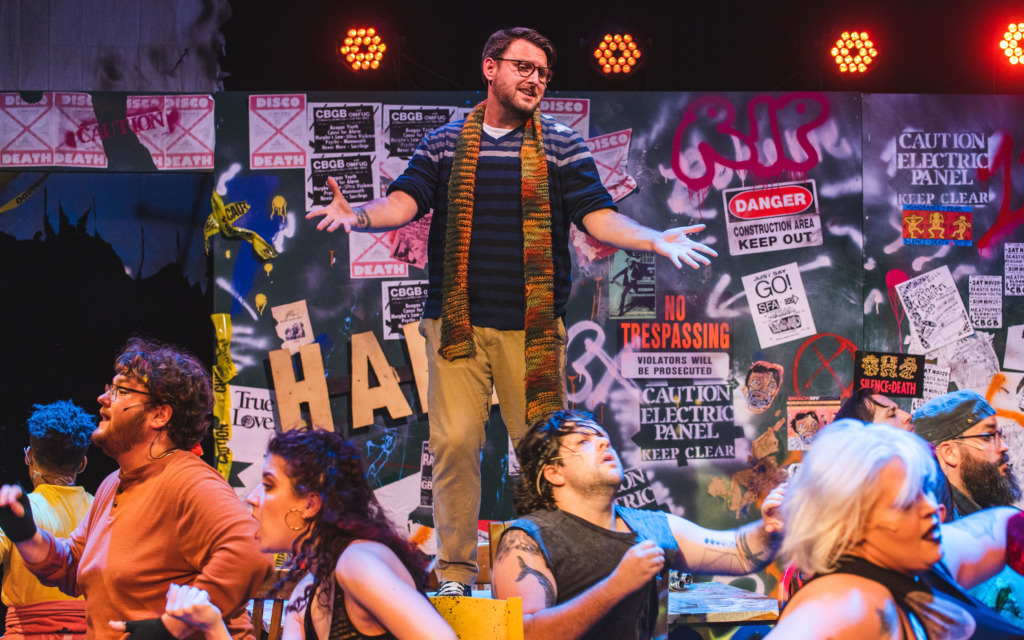
The show’s costumes are unlike any you could imagine for Rent though in the best way possible. In attempting to make this production “not your grandma’s Rent” (which is a very popular trend with mounting musical theatre post-pandemic, across the board) both Malek and Wardrobe Coordinator Amy Haynes Rapnicki have pulled out all the stops when it comes to clever, creative, fantastical costuming. Rent is an iconic show and while some characters are expected to appear in certain togs and threads— like Mark with his sort of disheveled scarf and glasses or Joanne in her posh suits and Doc Martins— Rapnicki and Malek breathe innovative life into retooling some of these costumes. When we first meet Angel, she’s in boring street clothes— but check that Christmas tree painted on the derriere of her jeans! (Gives excellent new meaning to Collins’ line “nice tree.”) Of course Angel gets a total transformation with a fluffy black petticoat, corset and a fabulous faux fur red and green tree-skirt cape! Maureen’s pants are also on point for “Over The Moon” colored in cow print, with MOOOOO printed across the seat of the pants, and spotted with other Elsie references. The detailed work on these costumes are just off the hook. Even the core-six (the non-named characters of the ensemble) get some pretty nifty threads, like that fur-coat seen early in the show on Ayanna Tucker; it looks like somebody swatch-sampled a sasquatch. The show’s costumes well-reflect that gritty, grungy, urban life of the early 90’s, matching the poster-graffiti plastered wall and Jonathan Larson’s reality.
In a space like Chesapeake Arts Center’s black box studio, sound can be a challenge. And while no theatre (not even the big touring houses, folks) ever gets perfect balance, Stuart Kazanow, with consult from William D’Eugenio, and board op Derek Anderson are working overtime to make sure that the music falls into balance with the vocalists and that the sound effects are clean, crisp, and delivered on time with their cues. Musical Director Rachel Sandler gets the rest of the credit for the incredible singing sounds you hear throughout the performance, corralling complex musical harmonies together in a way that just swells to fill the room with both tonal and emotional intensity. Having the entire cast ringing out at their peak vocals and emotional capacity during “Will I?” particularly at the very end of that number, is one of the more stunning vocal moments in the show. Sandler works to bring the duets of the show together in a way that really helps augment the natural talent of the performing cast, guiding some of the performers through some seriously impressive vocal options. This is particularly true of Benny’s character (played by Brian Paul Horshaw), who is showing off all sorts of range and technique every time he gets a moment in solo performance. Horshaw excels at delivering Benny’s uptight attitude as well as stunning vocals that make you wish Jonathan Larson had been able to include more solo singing opportunities for the character.
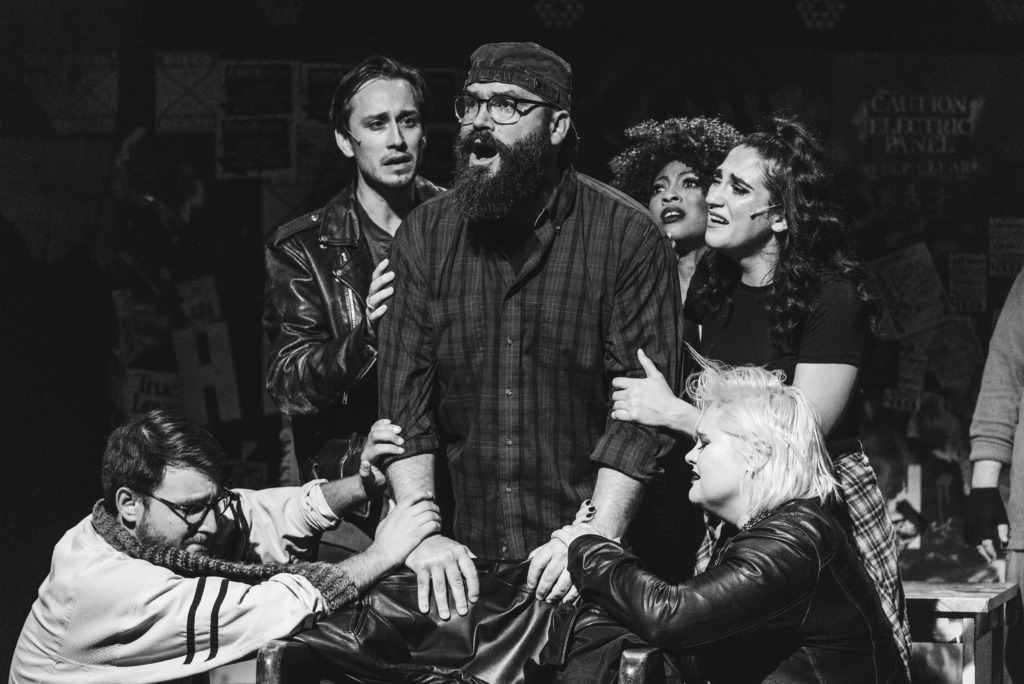
While the show may be overly choreographed and there may be a lot of extra concepts competing for attention on top of the show and the performers, Director Tommy Malek has assembled a stellar team of performers that really bring home the emotional gravitas of the show. There isn’t a performer on that stage who isn’t serving up professional quality realness. And some of Malek’s nuanced moments— like his construct of how Mimi is delivered and received during the penultimate number “Your Eyes”— are really striking and truly genius. The show is populated with these little crafted moments— like the back-end of “Take Me or Leave Me” being physically roped into a boxing match with Joanne declared as the winner” or the aforementioned setup for Mimi performing her “Out Tonight” as if she were working her shift at the Cat Scratch Club— that showcase Malek’s keen understanding of the show and his innovative creativity as a director.
Core Six (Alyssa Bell, Maddie Bohrer, Paul Kennedy, Ayanna Tucker, Tyler M. White, Max Wolf) are on the level with the named performers. It is a rare treat that you find an ensemble that is as vocally capable, and beyond capable, impressive as the principal and supporting singers. These six knock it out of the park when it comes to singing their featured songs, like “Life Support”, “Will I?” and “On the Street.” Their movement, despite the show’s propensity toward too much choreography, is well-informed by the musical structure of the songs. It would be inaccurate to say that they aren’t all vocal standouts. Paul Kennedy in particular has a striking vocal belt while Max Wolf has a fantastic display of volume control, particularly when delivering angry-song lines. Tyler M. White is arguably the most physically exuberant of them all, with a blend of ballet-gymnastic moves that are indefatigable as he leaps and spins all around the space. Ayanna Tucker gets one of the iconic verses during “Seasons of Love” and does not disappoint; Maddie Bohrer gives some sleazy smoothness to the ‘Alexi Darling’ character. And Alyssa Bell possesses fantastical body-doubling skills in addition to her singing and dancing. They are a well-oiled unit that really elevate the quality of the ensemble in this production.
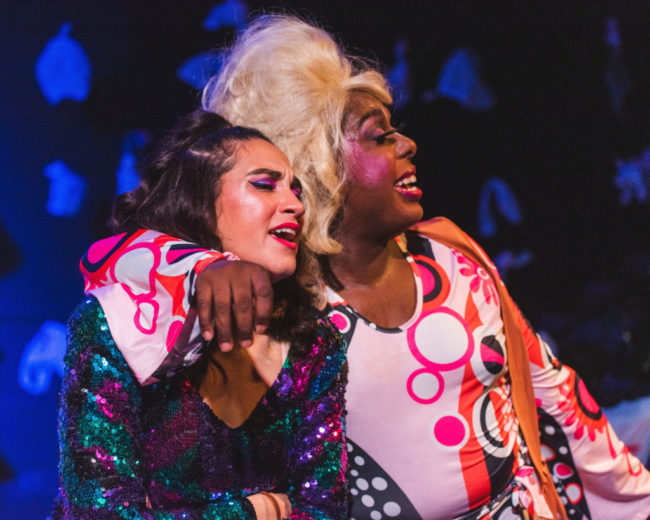
Playing up the more juvenile elements of Mimi, Emily Alvarado presents the character as a naïve, almost bratty, 19-year-old addict. Though the line is there in “Light My Candle” it’s rare to get such an immature take on Mimi and Alvarado really makes this approach work for the character in this context. There’s a lot of pouty faces and facial expressions that kids utilize that make them think they look older and more mature than they are. It sings to the sophomoric quality that Jonathan Larson intended for Mimi. Alvarado has a great voice and balances her character’s sexuality and physical signs of addiction in a curious but intriguing blend. All too often you see an overly confident Mimi strutting into Roger’s apartment for her introductory number; Alvarado is trying to be the sexy tease but her body showcases slight discomfort and uncertainty, which later vanishes when she’s rocking the hell out of “Out Tonight” (the split dichotomy of Mimi at work doing her job versus Mimi encountering someone she might have legitimate feelings for) and this is an impressive characterization choice that Alvarado really makes clear.
Serving up so much sass and ferocity in street clothes and glam clothes, Anwar Thomas simply slays as Angel. Even in the desperately endearing moment (which is a complete silent background moment shared with Collins while Mimi sings a heart-wrenching “Without You”) you’re drawn to what Thomas is doing. Flirty, fantastic, and full of so much charm and class, Thomas is making Angel this larger than life personality delivered in this earnest, honest fashion. “I’ll Cover You” and “Santa Fe” are two fabulous duets with Collins that really gives you a feel for who Thomas’ Angel really is. And the way he sashays all around the space during “Today 4 U” gives you more than a delicious taste of just what he can do in those knockout heels.
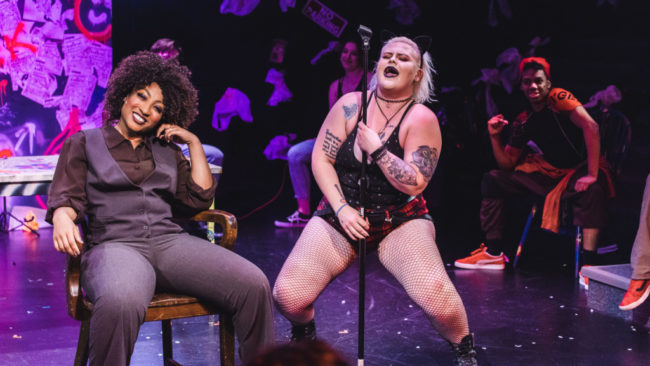
With a loud, proud voice, Samantha McEwen Deininger is the perfect fit for Joanne, who has to be both reserved and yet emotionally available all throughout the performance. The character of Joanne sometimes gets dismissed (almost immediately being introduced as ‘the other woman’ even though that isn’t exactly her dynamic, unless you’re Mark) but there’s no way you can write this character off in Deininger’s capable hands. Her facial expressions alone— and the way she both emotionally and vocally explodes during “We’re Okay” will just bowl you over. And when she takes to blasting her duet with Maureen, Deininger owns ever moment of “Take Me or Leave Me”, delivering vocal blow after blow to her opponent in the song (laying the groundwork for the metaphor-turned-slight-reality of the ‘boxing match’ that we see in this production.) Her parts of “Tango: Maureen” are just sensational as well.

Brendan Nicolas Pfeltz is serving up some Mark Cohen realness in his portrayal of the ‘protagonistic narrative leader.’ It’s everyone’s story, but it’s often viewed through Mark’s lens and Pfeltz does a solid job of creating those awkward moments that really ground the character in his complete cluelessness of “what the hell am I actually doing.” (Jonathan Larson’s as a self-insert into his own musical. Again.) There is moment, roughly midway through Act II, where Mark is alone on stage (and it’s so striking because he’s alone) and he sings this number, “Halloween” and while it’s arguably some of the most poetic lyrics in the song what’s most impressive about it is the way Pfeltz delivers that helpless fury of being angry and frustrated and not understanding how it all got to that point or why or how to fix it. It is one of the most human moments in the show (and that’s saying something because this show is basically a microscopic examination of moments that feature the human condition) and it is utterly moving. Pfeltz has some other impressive vocal moments, particularly when sparring off with the Roger character during “What You Own” and during the duet he share with Joanne, “Tango: Maureen.”
Taking point on one of the most tear-choking, heartbreaking moments, Collins (Ryan Wagner) delivers that sound of undeniable heartache that brings the tingles to your spine and the tears to your eyes during “I’ll Cover You (Reprise.)” It is a truly astonishing moment. When Wagner isn’t choking you up with ‘all the feels’ he’s rather jovial and giving the bright and optimistic side of Tom Collins, particularly when it comes to soaring his vocal prowess through “Santa Fe” and the initial “I’ll Cover You.” The chemistry cultivated between Wagner’s Collins and Thomas’ Angel feels genuine and authentic and gives you the twitterpated giggles of real love that blooms despite adversity and strife. With a formidable stage presence and a great vocal range, Wagner is an exceptional addition to the limitless talent of this cast.
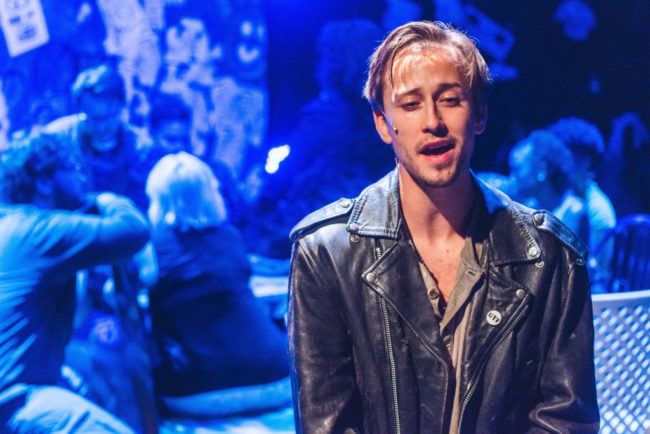
Channeling some Adam Pascal-Roger realness in that emo-boy-with-a-guitar sense, Garrett Zink is right on the money for the role Roger. While it would have been an added bonus if he could actually play the electric guitar (given the spacing of the black box studio, logistics could have been a factor there), Zink does a passable job of faking the fingering with the strings. But forget about the guitar because he’ll melt you with his angsty voice, particularly when crying out during “One Song Glory” and “Your Eyes.” There’s a lot of unchecked, undirected anger in Zink’s Roger; this is par for the course for most performers who take up the role of Roger and fits the bill for how Jonathan Larson penned the character. Zink really blasts out his own emotional turmoil in that vocal face-off (voice-off? pathos-off?) with Mark, which falls somewhere between Mark’s “Halloween” but before their smashing duo “What You Own.” (Technically I think it’s a part of “Goodbye Love” but that’s traditionally viewed as more of Mimi’s send-off song, though I guess it’s the top of that number where Mark and Roger start bickering.) Zink really revs up the anger when trying to push Mimi away (several times throughout the early phases of the show) but lets his true feelings shine through during that blasty-rocker solo “Your Eyes.”
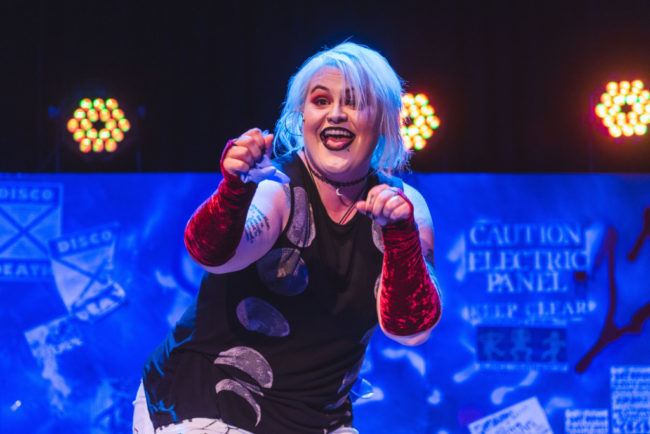
Stealing the thunder and jumping over the moon, Parker Bailey Steven gives an undeniably phenomenal performance as Maureen. As the character was originated by Broadway’s iconic legend, Idina Menzel, there’s really two directions you can go when playing Maureen; you either try to replicate what Menzel laid down or you tear it so far away from what she did and make it your own that Maureen is nearly an unrecognizable entity. Steven takes the latter approach and does so with vivacious success. With vocal dynamism, showmanship, and a fiery constitution that’s all well within her wheelhouse, Steven is delivering an unapologetic version of Maureen that is simply off the hook and wholly unhinged. “Over The Moon”, arguably one of the most bizarre moments in the show, becomes this anthem for experiencing life (Steven even switches up a section of the song to an acoustic clap-along to an infamous Queen number) and her half of “Take Me or Leave Me” is the knockdown, drag-out epitome of owning oneself. Steven brings an intriguing humanity to the character as well; her Maureen isn’t just the self-absorbed artistic monster that Larson penned her to be. There are levels, layers, and a whole mess of talents wrapped up in Steven’s portrayal. It’s truly sensational.
If you’re going to see a production of Rent this summer, Heritage Players’ production is pretty sensational; the talent resonating out of these 14 performers is utterly indescribable on a most mesmerizing and lingering level; their heartfelt singing and performing sticks with you long after you leave the theatre.
Running Time: Approximately 2 hours and 35 minutes with one intermission
Rent, a Heritage Players production, plays through July 23, 2022 in the Black Box Theatre at The Chesapeake Arts Center— 194 Hammonds Lane in Brooklyn Park, MD. Tickets are available for purchase at the door or in advance online.

